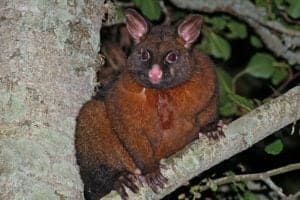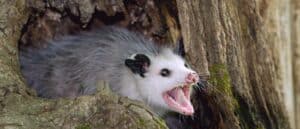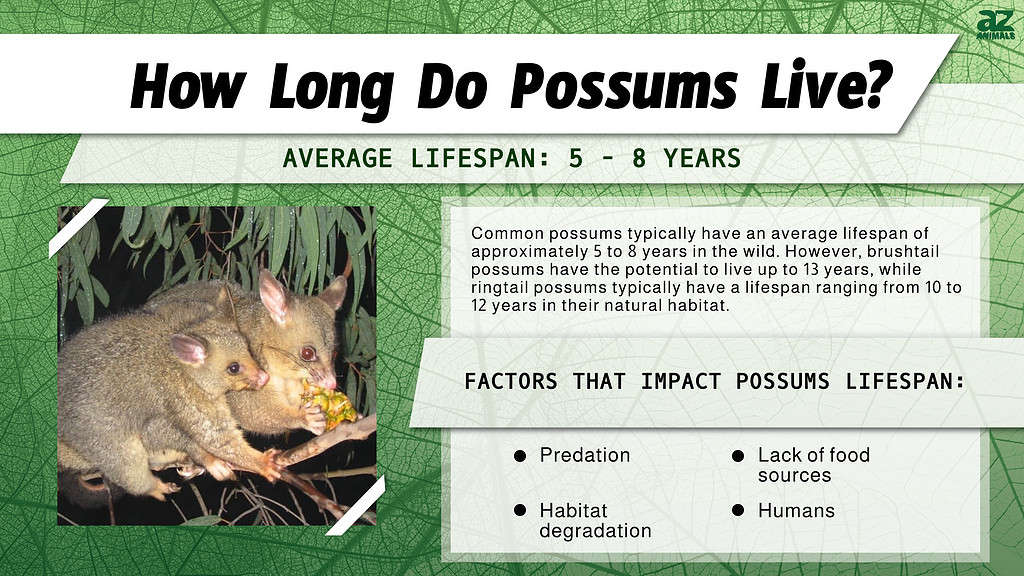
Possums, like kangaroos and koalas, are quintessential Australian animals. Their adorable and fluffy look, along with their non-aggressive temperament, makes them extremely popular with the locals. However, as an animal of the night (they’re nocturnal,) you’re more likely to spot a possum between dusk and dawn. While their cute appearance does win them the good graces of many locals, some people find them to be a pest as they often rummage, tend to consume anything they can, and seek refuge anyplace they feel comfortable, including under the roof of the home.
Let’s find out more about these furry little creatures, including the average possum lifespan and other fun facts!
A Quick Crash Course on Possums
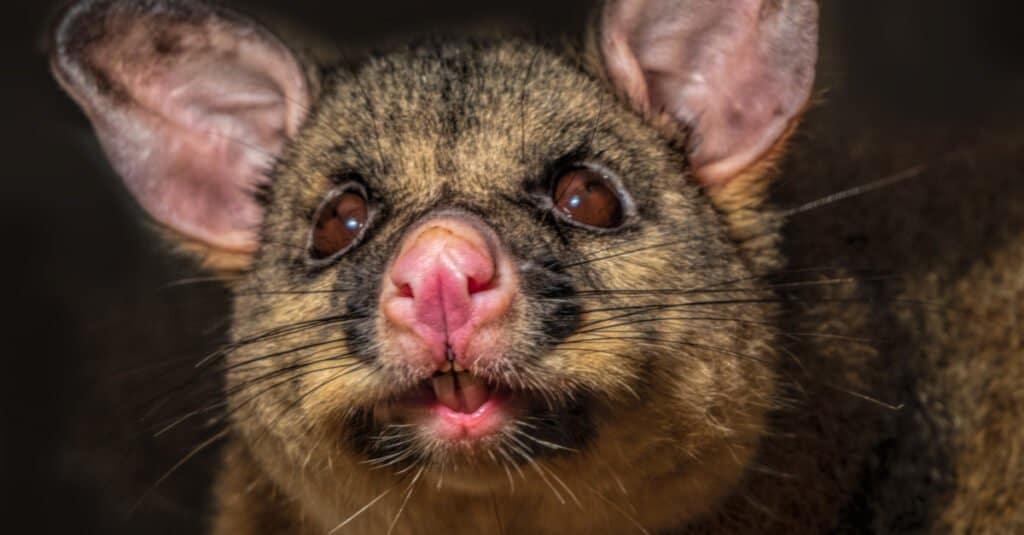
Possums are nocturnal marsupials, and most possums live in the hollows of tall trees.
©Carolyn Smith1/Shutterstock.com
In Australia, there are currently 27 different possum species. The common brushtail and ringtail possum are the most widespread species. Papua New Guinea and Sulawesi are also home to possums. Possums were brought into New Zealand in 1837 to develop the fur trade.
However, with no natural predators and an abundance of edible foliage, possums have become such a nuisance in New Zealand that The National Possum Handle Agencies were established in the early 1990s to control the problem.
As mentioned, possums are nocturnal marsupials. Most possums dwell in the hollows of large trees, but the common ringtail possum makes nests in shrubs or trees. Possums mostly consume eucalyptus, nectar, flowers, and fruit as well.
Now that we’ve got a better grasp of the possum, let’s learn all about its lifespan.
How Long Do Possums Live?
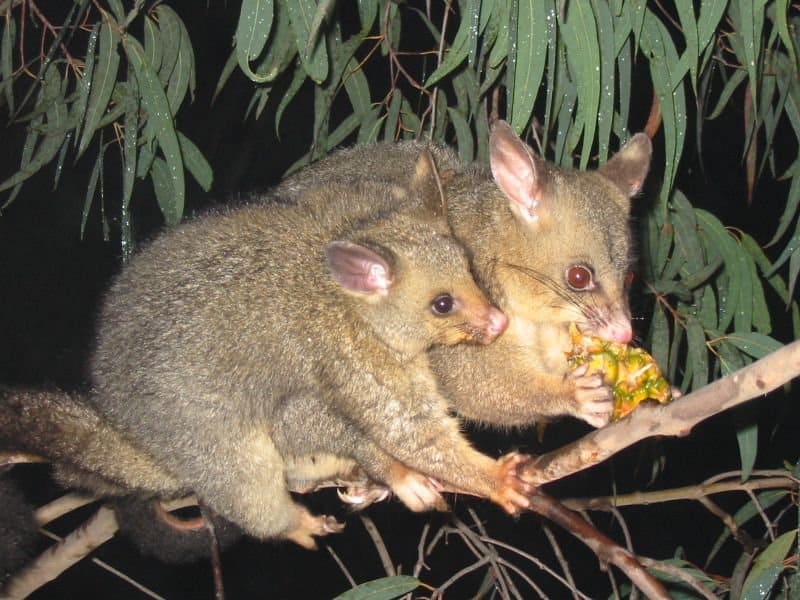
Possums are mostly herbivores and live up to 8 years in the wild.
©Peter Firminger / CC BY 2.0, Flickr – License
In the wild, the average lifespan for common possums is around 5 to 8 years. However, brushtail possums can live up to 13 years in the wild, while ringtail possums will live between 10-12 years.
When it comes to lifespan differences, females will often outlive their male counterparts in the wild. Female possum offspring have a greater survival rate than male young because they establish their home ranges closer to their mothers. However, males often move farther to find nesting sites. As a result, they are forced to abandon existing territories.
Female young from the Ōrongorongo river population in New Zealand remain with their mothers after weaning. Some then inherit ideal den locations from their mothers.
The Average Possum Life Cycle
Possums, like many other marsupials, all have a pretty common life cycle. Let’s explore it in detail and find out how they go from tiny babies to fully grown adults.
Gestation
Breeding can occur at any time of year, particularly for the common brushtail possum, although it is most prevalent in the spring. When they get pregnant, the females have a gestation period of 16–24 days before giving birth to a single child.
Newborn Possum
A newborn brushtail possum measures 1.5 cm in length and weighs around 2 grams. As is customary for marsupials, the newborn may climb unaided through the female’s fur and into the pouch, where it will latch onto a teat. The young grow and stay in the mother’s pouch for 4–5 months as it develops. Once the young are older, they stay in the den or ride on their mother’s back until they are 7–9 months old.
Adulthood
A possum is completely grown by 10 months of age. Females begin to reproduce for the first time around 12 months of age. Brush-tailed possums, in particular, prefer to live alone, except while reproducing. They stay to their ‘native habitat,’ which they designate by covering tree branches with a fragrance produced by glands on their chests. If two possums do happen to cross paths, they will try to avoid each other. They will also communicate with each other via hissing and growling, particularly during mating or scaring off intruders.
What Factors Impact The Possum Lifespan

Possums are a type of wildlife that is protected in Australia. Trapping, hunting, or killing possums is illegal unless appropriate licenses are obtained.
©Timothy Christianto/Shutterstock.com
Since possums mainly reside in the wild, there are many factors that contribute to the shortening of their lifespans. They have a lot more to watch out for, in terms of predators, having access to food, and losing their habitat. For example, the fairy possum, also known as Leadbeater’s possum, is under critical threat. This is due to fires, logging, and climate change.
Let’s take a look at some of these factors in detail:
- Predation: Brushtail possums, for example, are endangered in Australia by people, tiger quolls, dogs, foxes, cats, goannas, carpet snakes, and large owls. All of these animals are responsible for hunting them down either as a food source or in the case of humans, as a source of fur. Many humans also view possums as a pest, since many of them will find shelter in a home’s rooftop. People will hire exterminators to get rid of them in these sorts of cases.
- Lack of food sources: A lack of food sources due to climate change, habitat degradation, and more also pose a threat. Common Brushtail Possums are becoming less widespread in South Australia, particularly in dry areas where drought has limited their food supplies. They are now only exclusively found in Adelaide and on Kangaroo Island.
- Habitat degradation: The clearing away of many of their natural habitats is another huge threat. The mahogany glider, a species of possum, is an endangered species. This is due to the rapid destruction of its habitat for agriculture, cattle, and lumber. The highly endangered western ringtail possum faces many of the same challenges.
The photo featured at the top of this post is © Bryce McQuillan, CC BY-SA 2.0, via Wikimedia Commons – License / Original
Thank you for reading! Have some feedback for us? Contact the AZ Animals editorial team.



